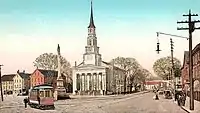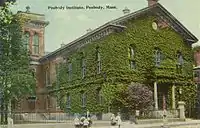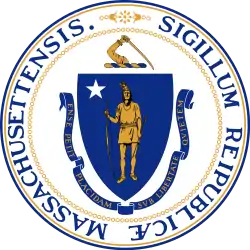Peabody, Massachusetts
Peabody (/ˈpiːbədi/) is a city in Essex County, Massachusetts, United States. The population was 51,251 at the 2010 census, and in 2019 the estimated population was 53,070. Peabody is located in the North Shore region of Massachusetts, and is known for its rich industrial history.
Peabody, Massachusetts | |
|---|---|
 Peabody City Hall | |
 Seal | |
| Nickname(s): Tanner City, The Leather City[1] | |
 Location in Essex County and the state of Massachusetts. | |
 Peabody, Massachusetts Location in the United States | |
| Coordinates: 42°31′40″N 70°55′45″W | |
| Country | |
| State | |
| County | Essex |
| Settled | 1626 |
| Incorporated | 1855 (Town) |
| Incorporated | 1916 (City) |
| Named for | George Peabody |
| Government | |
| • Type | Mayor-council city |
| • Mayor | Edward A. Bettencourt, Jr. |
| Area | |
| • Total | 16.81 sq mi (43.53 km2) |
| • Land | 16.23 sq mi (42.04 km2) |
| • Water | 0.57 sq mi (1.49 km2) |
| Elevation | 17 ft (5 m) |
| Population (2010) | |
| • Total | 51,251 |
| • Estimate (2019)[3] | 53,070 |
| • Density | 3,269.47/sq mi (1,262.35/km2) |
| Time zone | UTC−5 (Eastern) |
| • Summer (DST) | UTC−4 (Eastern) |
| ZIP code | 01960 / 01961 |
| Area code(s) | 351 / 978 |
| FIPS code | 25-52490 |
| GNIS feature ID | 0614307 |
| Website | www |
The area was long inhabited by Native American people known as the Naumkeag.[4][5][6]
The area was settled as part of Salem in 1626 by a small group of English colonists from Cape Ann led by Roger Conant. It was subsequently referred to as the Northfields, Salem Farms, and Brooksby.[7] Several area residents were accused of witchcraft during the Salem witch trials of the late 17th century, three of whom were executed (John Proctor, Giles Corey, and Martha Corey). [8]
In 1752, the area was set off from Salem, and incorporated as a district of Danvers. It was referred to as "the South Parish", associated with a church located in present-day Peabody Square. In 1855, the community broke away from Danvers, and was incorporated as the independent town of South Danvers. The name was changed to Peabody on April 30, 1868, in honor of George Peabody, noted philanthropist born in present-day Peabody, widely regarded as the "father of modern philanthropy". It was granted city status in 1916. The western, less densely populated area of town is often separately, yet unofficially, referred to as West Peabody.
Peabody started off as a farming community, but its rivers and streams attracted mills which operated by water power. In particular, Peabody was a major center of New England's leather industry, which attracted immigrants from all around the world.

By 1915, a third of the population was born outside the United States.[9] In addition to becoming home to large Irish and Russian populations, Peabody developed a large community of laborers hailing from the Ottoman Empire, mostly Turkish and Kurdish speakers from the region of Harput, now known as Elazığ.[9] The population was situated primarily on Walnut Street, where they filled boarding houses and coffee houses to such an extent that it became known as "Ottoman Street," and, more pejoratively and less accurately, "Peabody's Barbary Coast", as the United States was at war with the Ottoman Empire during World War I.[9] One visitor even noted that signs in town were written in both English and Ottoman Turkish.[9]
On the morning of October 28, 1915, twenty-one young girls were killed in the St. Johns School fire in the downtown area on Chestnut Street. The cause of the fire is believed to have been arson. Their bodies were found after the fire subsided, huddled together and burnt beyond recognition, near the entrance just steps away from survival. As a result, Peabody became the first city in the United States to establish a law that all entrances or exits in public buildings be push-open, rather than by handle or knob.[10][11]
The tanneries that lined Peabody's "Ottoman Street" remained a linchpin of the city's economy into the second half of the 20th century. The tanneries have since closed or been relocated elsewhere, but the city remains known locally as the Leather City or Tanner City. The mascot of Peabody Veterans Memorial High School is named the Tanners.
The loss of the tanneries was a huge blow to Peabody's economy, but the city has made up for the erosion of its industrial base, at least in part, through other forms of economic development. Early in the 20th century, Peabody joined the automobile revolution, hosting the pioneer Brass Era company, Corwin Manufacturing.[12]
The Northshore Mall, originally known as the Northshore Shopping Center, is one of the region's largest shopping malls. The mall opened in September 1958 as an outdoor shopping center, and was built on farm land originally owned by Elias Hasket Derby, one of America's first millionaires. Centennial Park,[13] an industrial park in the center of the city, has attracted several medical and technology companies. West Peabody, which was mostly farm land until the 1950s, has been developed into a middle-to-upper class residential area. Brooksby Farm,[14] a 275-acre (1.11 km2) working farm and conservation area has been one of the city's most popular destinations for decades.
Peabody is also the location of the Salem Country Club, a privately-owned country club with a professional golf course, which hosted the U.S. Senior Open in 2001 and 2017, and the U.S. Women's Open in 1954 and 1984.
Geography
Peabody is located at 42°32′3″N 70°57′41″W (42.534045, -70.961465).[15] According to the United States Census Bureau, the city has a total area of 16.8 square miles (43.5 km2), of which 16.2 square miles (42.0 km2) is land and 0.58 square miles (1.5 km2) or 3.46%, is water.[16] The northwestern border of Peabody lies along the Ipswich River, with brooks feeding it, and the Waters River, a tributary of the Danvers River, drains the northeast part of town. Several other ponds and a portion of Suntaug Lake lie within town. The largest protected portion of the city is the Brooksby Farm, whose land includes the Nathaniel Felton Houses.
The city is wedge-shaped, with the city center located in the wider southeast end. The neighborhood of South Peabody lies south of it, and the more suburban neighborhood of West Peabody, where the high school is, lies to the northwest of the city center, separated by the highways and the Proctor neighborhood. Peabody's center is 2 miles (3 km) from the center of Salem, and is 15 miles (24 km) northeast of Boston, 18 miles (29 km) west-southwest of Gloucester, and 18 miles (29 km) southeast of Lawrence. Peabody is bordered by Middleton to the northwest, Danvers to the north, Salem to the east, Lynn to the south and Lynnfield to the southwest.
Demographics
| Year | Pop. | ±% |
|---|---|---|
| 1860 | 6,549 | — |
| 1870 | 7,343 | +12.1% |
| 1880 | 9,028 | +22.9% |
| 1890 | 10,158 | +12.5% |
| 1900 | 11,523 | +13.4% |
| 1910 | 15,721 | +36.4% |
| 1920 | 19,552 | +24.4% |
| 1930 | 21,345 | +9.2% |
| 1940 | 21,711 | +1.7% |
| 1950 | 22,645 | +4.3% |
| 1960 | 32,202 | +42.2% |
| 1970 | 48,080 | +49.3% |
| 1980 | 45,976 | −4.4% |
| 1990 | 47,039 | +2.3% |
| 2000 | 48,129 | +2.3% |
| 2010 | 51,251 | +6.5% |
| 2019 | 53,070 | +3.5% |
| * = population estimate. Source: United States Census records and Population Estimates Program data.[17][18][19][20][21][22][23][24] Source: | ||
As of the census of 2010,[16] there were 51,251 people living in the city and a total of 22,220 housing units. The racial makeup of the city was 90.4% White, 2.4% African American, 6.3% Hispanic or Latino of any race (1.3% Puerto Rican, 0.3% Mexican, 0.1% Cuban, and 4.5% other Hispanic or Latino), 1.9% Asian, 3.8% from other races, and 1.6% from two or more races.
There were 21,313 households, of which 26.8% included children under the age of 18, 48.4% were married couples living together, 10.7% had a female householder with no husband present, and 37.1% were non-families. 31.4% of all households were made up of individuals, and 16.3% had someone living alone who was 65 years of age or older. The average household size was 2.28, and the average family size was 3.02.
In the city, the population was spread out, with 21.1% under the age of 20, 22.5% from 20 to 39, 29.8% from 40 to 59, and 26.5% who were 60 years of age or older. The median age of people in Peabody was 44.6. For every 100 females, there were 90.3 males. For every 100 females age 18 and over, there were 86.9 males.
The median income for a household in the city was $65,515, and the median income for a family was $80,471. Males had a median income of $55,352 versus $44,167 for females. About 4.4% of families and 6.3% of the population were below the poverty line, including 5.8% of those under age 18 and 7.9% of those age 65 or over.
In the April 2009 edition of Forbes magazine, Peabody was ranked the 14th most livable city in the United States.[26]
Government
Peabody is represented in the state legislature by officials elected from the following districts:
Economy

- Major employers
- Analogic Corporation
- Boston Children's Hospital
- Boston Acoustics
- Carl Zeiss AG
- Christian Book Distributors
- JEOL
- Lahey Hospital & Medical Center
- Meridian Interstate Bancorp
- Northshore Mall
- Rousselot Gelatine (formerly a division of Kodak)
- Saucony
- UTC Aerospace Systems
Education
Peabody Veterans Memorial High School, a grade 9-12 public high school serving Peabody residents. The athletic teams are known as the Peabody Tanners. As of April 2008, there were 1,898 students enrolled in the school, and 146 teachers.[29]
Bishop Fenwick High School, a Catholic private high school serving the entire North Shore region, is located in the city near the boundary with Salem, Danvers, and Beverly. As of 2017, enrollment is just under 600 students.
J. Henry Higgins Middle School, a grade 6-8 public middle school, with a hawk as its mascot.
Covenant Christian Academy, a Christian and classical preparatory school for students Pre-K through 12th grade. Moved into the old John F. Kennedy Junior High School in West Peabody in 2005. They serve students from over 45 cities and towns in eastern Massachusetts.
St. John The Baptist School, a private Catholic school that teaches up to grade 8. It currently has approximately 400 students.
Infrastructure
Transportation
Peabody is the site of the junction of Interstate 95, Massachusetts Route 128 and U.S. Route 1. After the junction with Route 1, the two highways split, with Interstate 95 going north and Route 128 going east towards Gloucester and Cape Ann. Massachusetts Route 114 passes through the northeast corner of town, going from Danvers towards Salem, with an intersection at Route 128's Exit 25, next to the Northshore Mall. The southern terminus of Route 35 is at Route 114, just a half mile before Route 114 enters Salem.
Several lines of the MBTA bus service pass through town. The Logan Express also stops on Route 1 in Peabody. The Springfield Terminal rail line passes through town, with one line passing from Lynnfield towards Danvers, and another, mostly abandoned, line passing from Middleton to Salem. The nearest commuter rail service is in Salem, along the Newburyport/Rockport Line of the MBTA Commuter Rail, with service to Boston's North Station. The nearest airport is the Beverly Municipal Airport, and the nearest national and international air service is located at Boston's Logan International Airport.
Utilities
The municipally-owned Peabody Municipal Light Plant provides electricity to the city. Natural gas service in Peabody is provided by National Grid. Cable television in Peabody is provided by Comcast and the City in June 2019 issued a second Cable TV license to RCN.[30][31]
Notable people
- Jeff Allison, former professional baseball pitcher for the Florida Marlins from 2003 to 2011.
- Matt Antonelli, former second basemen for the San Diego Padres of Major League Baseball
- Samantha Arsenault, Olympic swimmer champion.
- Frederick Berry, disability rights advocate, state senator from 1983 to 2003, majority leader of the Massachusetts State Senate from 2003 to 2013.
- Matt Bloom, professional wrestler.
- Nathaniel Bowditch, early American astronomer, mathematician, and navigator.
- Patrick Francis Bresnahan, United States Navy veteran, Medal of Honor.
- Kimberly S. Budd, Chief Justice of the Massachusetts Supreme Judicial Court.
- Bobby Carpenter, NHL player in the 1980s and 1990s.
- Giles Corey, victim of the Salem witch trials.
- Martha Corey, victim of the Salem witch trials.
- Chick Davies, Major League Baseball player.
- Brad Delp, lead singer of the band Boston
- Jerry DeLucca, former professional football player in New England Patriots.
- Mary Upton Ferrin, American suffragette and women's rights advocate.
- Gary Gulman, comedian.
- Bobby Hanson, professional hockey player and actor.
- Hrishikesh Hirway, musician and vocalist of The One AM Radio.
- Daniel P. King, congressman from 1843 to 1850.
- Christina Kirkman, teen actress, comedian, and circus performer.
- Joe Klein, author, journalist (worked for The Peabody Times in the 1970s).
- Rejean "Reggie" Lemelin, professional ice hockey player of Boston Bruins.
- Steve Lomasney, former Major League Baseball player.
- Nicholas Mavroules, mayor from 1967 to 1978, congressman 1979 to 1993.
- Ryan Montbleau, professional musician.
- Jonathan Mover, professional drummer.
- George Peabody, merchant, philanthropist, and namesake of the city.
- Marc Predka, rapper known as Tha Trademarc.
- John Proctor, victim of the Salem witch trials.
- Patricia Goldman-Rakic, pioneering neuroscientist and professor.
- Ruth Shoer Rappaport, scientist and vaccine researcher.
- Pauline Sperry, mathematician.
- John J. Studzinski, Investment banker and philanthropist.
- John Tudor, Major League Baseball pitcher from 1979 to 1990.
- Rochelle Walensky, physician-scientist, director of the Centers for Disease Control and Prevention from 2021 to present.
- Jack Welch, industrialist.
- Nancy Werlin, book author
References
- Claims to Fame - Products Archived 2007-04-08 at the Wayback Machine, Epodunk, accessed April 16, 2007.
- "2019 U.S. Gazetteer Files". United States Census Bureau. Retrieved July 25, 2020.
- "Population and Housing Unit Estimates". United States Census Bureau. May 24, 2020. Retrieved May 27, 2020.
- "The Naumkeag". PIONEER VILLAGE. Retrieved 2020-12-28.
- Writer, Dustin Luca Staff. "President Jackson's portrait to make way for Naumkeag leader". Salem News. Retrieved 2020-12-28.
- "MASSACHUSETTS INDIGENOUS COMMUNITY RESOURCES". Salem Historical Society. Retrieved 2020-12-28.
- "History | Peabody Historical Society". Retrieved 2020-12-28.
- "Welcome to Peabody". Salem Witch Museum. Retrieved 2020-12-28.
- Acehan, Işıl (December 2009). ""Ottoman Street" in America: Turkish Leatherworkers in Peabody, Massachusetts". International Review of Social History. 54: 19–44. doi:10.1017/S0020859009990228.
- Gendisasters.com Archived 2007-12-05 at the Wayback Machine
- NFPA.org Archived 2007-09-30 at the Wayback Machine
- Clymer, Floyd. Treasury of Early American Automobiles, 1877-1925 (New York: Bonanza Books, 1950), p.158.
- "Peabody-works.com". Archived from the original on 2017-10-26. Retrieved 2008-01-24.
- Essexheritage.org Archived 2007-12-22 at the Wayback Machine
- "US Gazetteer files: 2010, 2000, and 1990". United States Census Bureau. 2011-02-12. Retrieved 2011-04-23.
- "Geographic Identifiers: 2010 Demographic Profile Data (G001): Peabody city, Massachusetts". American Factfinder. U.S. Census Bureau. Archived from the original on February 13, 2020. Retrieved February 10, 2016.
- "TOTAL POPULATION (P1), 2010 Census Summary File 1, All County Subdivisions within Massachusetts". United States Census Bureau. Archived from the original on February 12, 2020. Retrieved September 13, 2011.
- "Massachusetts by Place and County Subdivision - GCT-T1. Population Estimates". United States Census Bureau. Archived from the original on February 12, 2020. Retrieved July 12, 2011.
- "1990 Census of Population, General Population Characteristics: Massachusetts" (PDF). US Census Bureau. December 1990. Table 76: General Characteristics of Persons, Households, and Families: 1990. 1990 CP-1-23. Archived from the original (PDF) on December 7, 2013. Retrieved July 12, 2011.
- "1980 Census of the Population, Number of Inhabitants: Massachusetts" (PDF). US Census Bureau. December 1981. Table 4. Populations of County Subdivisions: 1960 to 1980. PC80-1-A23. Retrieved July 12, 2011.
- "1950 Census of Population" (PDF). 1: Number of Inhabitants. Bureau of the Census. 1952. Section 6, Pages 21-10 and 21-11, Massachusetts Table 6. Population of Counties by Minor Civil Divisions: 1930 to 1950. Retrieved July 12, 2011. Cite journal requires
|journal=(help) - "1920 Census of Population" (PDF). Bureau of the Census. Number of Inhabitants, by Counties and Minor Civil Divisions. Pages 21-5 through 21-7. Massachusetts Table 2. Population of Counties by Minor Civil Divisions: 1900, 1910, and 1920. Retrieved July 12, 2011.
- "1890 Census of the Population" (PDF). Department of the Interior, Census Office. Pages 179 through 182. Massachusetts Table 5. Population of States and Territories by Minor Civil Divisions: 1880 and 1890. Retrieved July 12, 2011.
- "1870 Census of the Population" (PDF). Department of the Interior, Census Office. 1872. Pages 217 through 220. Table IX. Population of Minor Civil Divisions, &c. Massachusetts. Retrieved July 12, 2011.
- "Census of Population and Housing". Census.gov. Retrieved June 4, 2015.
- Forbes.com
- Massachusetts General Court, "An Act Establishing Executive Councillor and Senatorial Districts", Session Laws: Acts (2011), retrieved August 23, 2020
- "Massachusetts Representative Districts". Sec.state.ma.us. Retrieved August 23, 2020.
- Public Schools of Peabody Massachusetts
- . Salem Evening News https://www.salemnews.com/news/local_news/second-cable-provider-coming-to-peabody/article_a7007acb-0f90-5de8-a0e5-39cb931ba50c.html. Missing or empty
|title=(help) - MassUtilities (Map). MassGIS. Retrieved November 22, 2017.
External links
| Wikimedia Commons has media related to Peabody, Massachusetts. |
| Wikisource has the text of the 1911 Encyclopædia Britannica article Peabody. |







